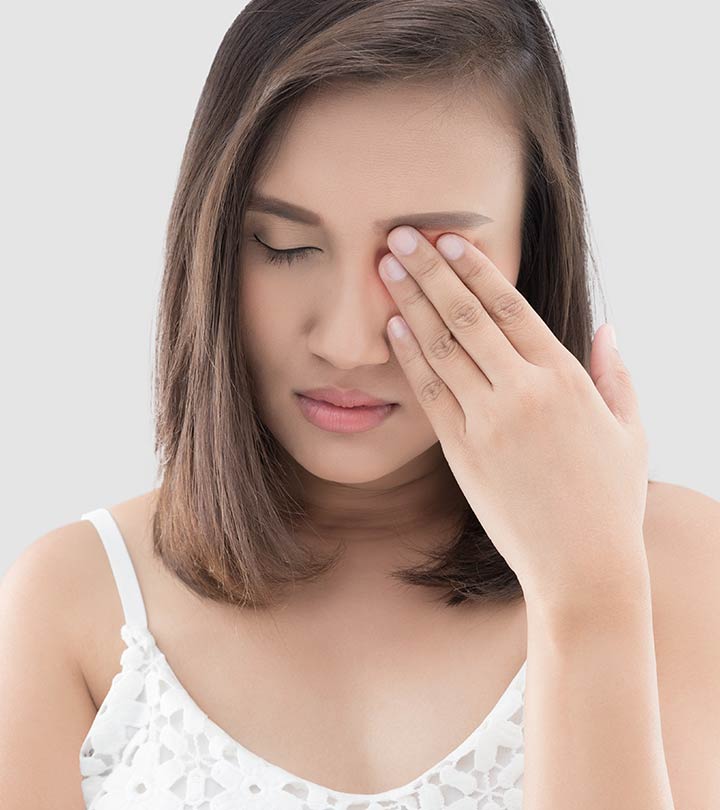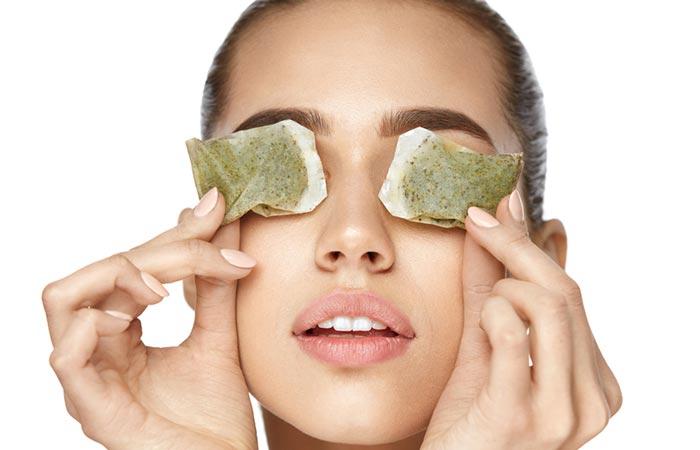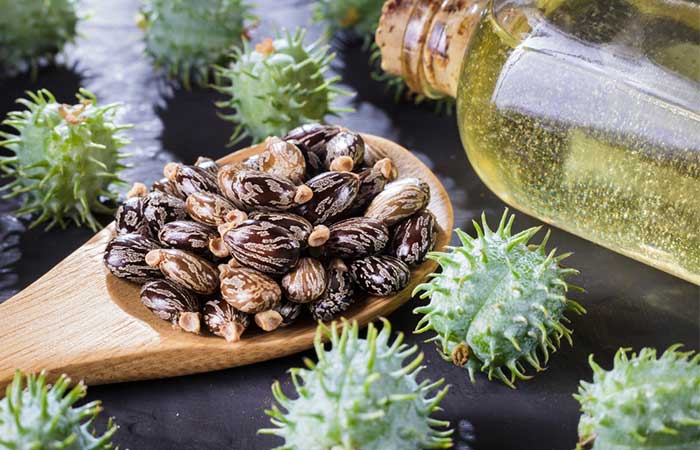Is
your eyelid swollen? Do you have discharge accumulating in the corner
of an eye? Does your eye hurt every time you blink? If you answered yes
to any of these questions, you have most probably developed an eye
infection. Eye infections are plain scary and may lead to discomfort and
pain until the symptoms subside.
What can you do to speed up your recovery from such infections? How can you reduce the severity of the symptoms? Find out answers to all of these and more – right here. Keep reading.
If you have an eye infection, the symptoms will most probably occur in your:
What can you do to speed up your recovery from such infections? How can you reduce the severity of the symptoms? Find out answers to all of these and more – right here. Keep reading.
Table Of Contents
- What Is An Eye Infection?
- Signs And Symptoms
- Types And Causes Of Eye Infections
- Risk Factors
- Diagnostic Tests
- Home Remedies To Treat Eye Infections
- Best Foods For Eye Health
- How To Prevent Eye Infections
What Is An Eye Infection?
If any of your eyes has turned itchy or a shade of pink, the chances of infection cannot be overruled.If you have an eye infection, the symptoms will most probably occur in your:
- Eyelids
- Cornea – The clear surface that covers the outside of your eye.
- Conjunctiva – The thin and moist area that covers the inside of the eyelids along with the outer layer of your eye.
Signs And Symptoms
Your eyes may feel weird, and you may experience issues like:- Pain
- Discomfort
- Itchiness
- Irritation or hurt when exposed to direct sunlight
- Burning
- Small and painful lumps in or around your eyelids or eyelashes
- Tender eyelids
- Constant tearing
- Your eyes may be swollen or red.
- You develop a pink tint in the whites of your eyes.
- There may be a yellowish or greenish discharge from one or both eyes. It may even be clear.
- Your eyelashes and/or eyelids may have a crusty substance surrounding them in the morning.
The cause of an eye infection may vary from a microbial infection to an irritation caused by an allergic reaction or irritant. The cause also varies depending on the infection type.
Types And Causes Of Eye Infections
The most common types of eye infections and their respective causes are:- Pink Eye Or Conjunctivitis – This is an infection of the conjunctiva of your eyes, which tends to make them look pink. It is often caused by a bacteria or virus, but sometimes, it may also be caused by an allergic reaction or an irritant.
- Keratitis – This is a common infection in people who wear contact lenses. It affects the cornea and may be caused by bacteria, viruses, or other parasites.
- Stye – It can appear as painful red bumps under your eyelid or at the base of your eyelashes. It is a result of an infected oil gland in your eyelid or eyelashes.
- Fungal Infections – While fungal eye infections are quite rare, they can be dangerous when they occur. Such infections often occur following an eye injury, especially if your eye was scraped by a plant or thorn. Fungal infections can also occur in individuals who wear contact lenses without cleaning them properly.
- Uveitis – This infection affects the middle layer of your eye, called the uvea. In some cases, such infections are linked to inflammatory diseases like lupus or rheumatoid arthritis.
Risk Factors
- Medical conditions like gonorrhea, chlamydia, bacterial keratitis, or shingles
- Herpes simplex virus infections
- Tuberculosis
- Sharing utensils like towels or sheets with an infected individual
- Clogged tear ducts
- Extended contact lens wear
- Exposure to irritants like dust or other such substances
- Chemical splash
- Entry of a foreign object into your eyes
Diagnostic Tests
Your doctor will begin by asking you about your signs and symptoms along with an analysis of your medical history.The signs and symptoms are usually enough to diagnose your condition. In rare cases, your doctor may suggest taking a sample of the liquid that may have drained out of your eyes for laboratory culture. This sample may be cultured if a high-risk cause is suspected, such as a serious infection or the presence of a foreign body in your eye.
Depending on the cause, topical or oral medications may be prescribed.
Natural Ways To Treat Eye Infections
1. Breast Milk
You Will Need
1-2 drops of breast milkWhat You Have To Do
Pour one to two drops of breast milk into your infant’s eyes.How Often You Should Do This
You can do this 2-3 times daily for neonatal conjunctivitis.Why This Works
Many newborns suffer from eye infections like conjunctivitis. The administration of breast milk (colostrum) is a proven method to prevent and manage neonatal conjunctivitis (1).2. Essential Oils
You Will Need
- 3-4 drops of tea tree, rosemary, thyme, or peppermint oil
- A bowl of hot water
- A towel or blanket
What You Have To Do
- Fill a large bowl with hot water.
- Add three to four drops of any essential oil to it.
- Bend over the bowl and allow your skin to absorb the steam.
- Cover your head with a towel or blanket so that the steam doesn’t escape.
How Often You Should Do This
You can do this 1-2 times daily.Why This Works
The antimicrobial nature of the essential oils of tea tree, thyme, peppermint, and rosemary can help fight the microbes responsible for causing eye infections (2).3. Green Tea Bag
You Will Need
Used green tea bagsWhat You Have To Do
- Take a couple of used green tea bags and refrigerate them.
- Place the cold tea bags on closed eyes.
- Leave them on for 15-20 minutes.
- Remove them.
How Often You Should Do This
You can do this 1-2 times daily.Why This Works
Green tea extract can help alleviate ocular inflammation, which is one of the main symptoms triggered by eye infections (3).4. Honey
You Will Need
- ½ cup of water
- 2 ½ teaspoons of honey
- Dropper
What You Have To Do
- Boil half a cup of water.
- Allow it to cool. Add honey to it. Mix well.
- Using a dropper, put one to two drops of honey in each eye.
- Blink away the excess.
How Often You Should Do This
You can do this 3-4 times daily.Why This Works
The anti-inflammatory and antimicrobial nature of honey can help treat eye infections like keratoconjunctivitis (4).5. Turmeric
You Will Need
- 1 teaspoon of turmeric powder
- 1 cup of warm water
- A clean washcloth
What You Have To Do
- To a cup of water, add a teaspoon of turmeric and stir well.
- Bring the water to a boil and turn the stove off.
- Allow the turmeric solution to cool for a while.
- Soak a clean washcloth in the solution and use it as a warm compress for your eyes.
How Often You Should Do This
You may do this 1-2 times daily.Why This Works
The active component of turmeric is curcumin. This compound can help alleviate symptoms of eye infections like conjunctivitis with its anti-inflammatory and antimicrobial properties (5).6. Apple Cider Vinegar
You Will Need
- 1-2 teaspoons of raw apple cider vinegar
- 1 cup of warm water
- Cotton balls
What You Have To Do
- Add one to two teaspoons of raw apple cider vinegar to a cup of warm water.
- Mix well and soak a cotton ball in the solution.
- Wring out the excess solution and place the cotton ball over closed eyes.
- Leave it on for 15-20 minutes and then remove it.
How Often You Should Do This
You may do this 1-2 times daily for best results.Why This Works
The antimicrobial properties exhibited by apple cider vinegar can be quite effective in combating the microbes responsible for causing eye infections (6).7. Lemon Juice
You Will Need
- ½ lemon
- 1 glass of water
What You Have To Do
- Squeeze the juice from half a lemon into a glass of water.
- Mix well and drink up.
How Often You Should Do This
You can drink lemon juice once daily for optimum benefits.Why This Works
Lemon juice is a great remedy for those experiencing eye infections due to allergies. The anti-inflammatory and antioxidant nature of lemons could be responsible for this (7).8. Salt Water
You Will Need
- 1 teaspoon of salt
- 500 mL of distilled water
What You Have To Do
- Add a teaspoon of salt to 500 mL of water and mix well.
- Use the solution to wash both your eyes thoroughly.
How Often You Should Do This
You may do this 2-3 times daily.Why This Works
The antiseptic nature of saline water can help fight eye infections, thereby speeding up your recovery (8). You can also follow this remedy before you apply any topical formulations.9. Aloe Vera
You Will Need
- Aloe vera gel (as required)
- Cotton swabs
What You Have To Do
Apply aloe vera gel around the affected eye with a cotton swab.How Often You Should Do This
You may do this 1-2 times daily until you notice an improvement in your condition.Why This Works
Aloe vera contains compounds like ethanol and ethyl acetate that can help alleviate symptoms of inflammation and swelling associated with eye infections (9).10. Hot Or Cold Compress
You Will Need
Hot or cold compressWhat You Have To Do
- Apply a hot or cold compress to the affected eye.
- Leave it on for 2-3 minutes. Remove.
- Repeat twice.
How Often You Should Do This
You may do this 1-2 times daily.Why This Works
Hot as well as cold compresses can help speed up the healing of eye infections by reducing the symptoms of inflammation, itching, and swelling and preventing the spread of the infection (10).11. Vitamins
Nutritional deficiencies can also make you prone to eye infections. Vitamins C, E, and A are beneficial for promoting ocular health (11). It can prevent oxidative damage to your eyes and also help fight infections.Foods rich in these vitamins include citrus fruits, leafy vegetables, carrots, fish, cheese, and nuts. You should consult your doctor if you plan on taking additional supplements for these vitamins.
12. Castor Oil
You Will Need
- 1-2 teaspoons of castor oil
- A clean washcloth
- Water
What You Have To Do
- Apply castor oil around your eyes.
- Soak a clean washcloth in warm water.
- Wring out the excess water and apply the warm compress over your eyes.
- Leave it on for 5-10 minutes.
How Often You Should Do This
You may do this once daily for best results.Why This Works
Castor oil possesses impressive anti-inflammatory and lubricating properties that can help in reducing the swelling and pain in your eyes and prevent your tears from evaporating (12), (13).These remedies can help you combat eye infections. But, remember, it is important that you focus on your diet as well to deal with eye infections and boost eye health.
Best Foods For Eye Health
Antioxidant-rich foods are beneficial for your eyes. Also, nutrients like vitamin C, omega-3 fatty acids, lutein, zinc, and vitamin E are known to help ward off age-related vision problems.Some foods rich in these nutrients are:
- Indian gooseberry (amla), which is a rich source of vitamin C, can help prevent visual problems like cataract (14).
- Salmon, tuna, and other similar fatty fish rich in omega-3 fatty acids (15).
- Protein-rich foods like eggs, nuts, and beans.
- Vitamin C-rich fruits and green leafy vegetables.
- Oysters, which are rich in vitamins C and E, iron, and zinc.
How To Prevent Eye Infections
- Wash your hands with soap and water before and after you touch your eyes.
- Do not rub or touch your eyes constantly.
- Clean any discharge that may be oozing from your eyes. Discard the used cotton balls. Don’t forget to wash your hands following this.
- Avoid using the same dropper/dispenser for your infected and non-infected eyes.
- Wash your sheets, pillowcases, and towels regularly using hot water and detergent.
- Stop using your contact lenses unless the doctor gives you clearance.
- Clean your eyeglasses regularly.
- Do not share your personal utensils with others.
- Avoid using swimming pools until your condition improves.
Source Click here













Comments
Post a Comment